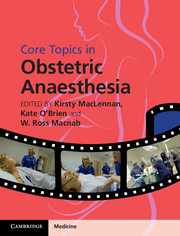Book contents
- Frontmatter
- Contents
- List of contributors
- Preface
- Section 1 Basic science, epidemiology and service organization
- Section 2 Obstetric aspects
- 5 Maternal critical care
- 6 Obstetrics for the anaesthetist
- 7 Antenatal assessment
- Section 3 Provision of anaesthesia
- Section 4 Medical conditions in pregnancy
- Section 5 Postpartum complications and obstetric emergencies
- Section 6 Service organization
- Index
- Plate section
- References
6 - Obstetrics for the anaesthetist
from Section 2 - Obstetric aspects
Published online by Cambridge University Press: 05 December 2015
- Frontmatter
- Contents
- List of contributors
- Preface
- Section 1 Basic science, epidemiology and service organization
- Section 2 Obstetric aspects
- 5 Maternal critical care
- 6 Obstetrics for the anaesthetist
- 7 Antenatal assessment
- Section 3 Provision of anaesthesia
- Section 4 Medical conditions in pregnancy
- Section 5 Postpartum complications and obstetric emergencies
- Section 6 Service organization
- Index
- Plate section
- References
Summary
Intrapartum care at or near term gestation
Intrapartum care is a challenging and rapidly changing environment for all health professionals. As an obstetrician the key question is often ‘Do I need to intervene? And if so, how much time do I have to do this?’ Fetal monitoring, recommendation of mode and timing of delivery is aimed at reducing poor neonatal outcomes.
Within the scope of this chapter it is not possible to cover all potential intrapartum events that may require anaesthetic assessment and input. The aim of this chapter is to provide enough information on fetal monitoring to enable the anaesthetist to understand the urgency of a delivery and how this is determined in high-risk cases such as twins and vaginal breech delivery.
Intrapartum fetal monitoring
Intrapartum fetal monitoring techniques have enabled obstetricians to intervene and prevent the development of a severe hypoxia. However, these techniques are far from perfect. The mainstay of fetal intrapartum monitoring remains the cardiotocograph (CTG), which records the fetal heart rate (FHR) and the presence of uterine contraction activity using the tocograph. This is recommended by NICE for all ‘high-risk’ labours. Although not exhaustive, indications for continuous intrapartum CTG monitoring are listed below:
• Meconium-stained liquor
• Abnormal FHR detected by intermittent auscultation
• Maternal pyrexia of 38 °C on one occasion or 37.5°C on two occasions, 2 hours apart
• Fresh bleeding developing in labour
• Oxytocin use for augmentation
• Multiple pregnancy
• Vaginal breech delivery
• Maternal request
• Fetal growth restriction
• Preterm labour
• Maternal disease (pre-eclampsia, obstetric cholestasis).
The evidence for these recommendations is derived from observational studies rather than randomized controlled trials. The poor quality of these studies, which were performed more than 20 years ago, has resulted in a lack of evidence for CTG use in low-risk women. Therefore although it might seem counterintuitive to the anaesthetist to reduce the amount of monitoring information available to doctors and midwives caring for women in labour, current NICE guidance does not support the use of CTG in this group. A Cochrane review on continuous CTG during labour demonstrated a reduction in neonatal seizures, but no significant differences in cerebral palsy or infant mortality rates. This was offset by increases in caesarean section and instrumental vaginal birth rates.
- Type
- Chapter
- Information
- Core Topics in Obstetric Anaesthesia , pp. 35 - 43Publisher: Cambridge University PressPrint publication year: 2015



